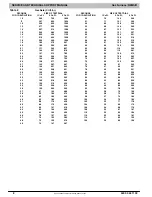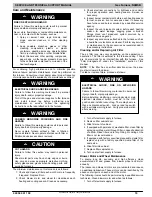
SERVICE AND TECHNICAL SUPPORT MANUAL
Gas Furnace: N9MSB
Specifications subject to change without notice.
20
440 04 4411 03
7. Clean heat exchanger openings with a vacuum and a
soft brush. (See
Figure 12
Cleaning Heat Exchanger Cell
A11273
NOTE
: After cleaning, inspect the heat exchangers to ensure
they are free of all foreign objects that may restrict flow of
combustion products.
8. Reverse items 6 through 1 for reassembly.
9. Refer to furnace wiring diagram and reconnect wires to
flame rollout switch, gas valve, igniter, and flame sensor.
10. Turn on gas and electrical supplies to furnace.
11. Check furnace operation through two complete heat
operating cycles. Look at burners. Burner flames should
be clear blue, almost transparent. (See
)
Figure 13
Burner Flame
A11461
Burner Flame
Burner
Manifold
FIRE OR EXPLOSION HAZARD
Failure to follow this warning could result in personal
injury, death, and/or property damage.
Never purge a gas line into a combustion chamber.
Never test for gas leaks with an open flame. Use a
commercially available soap solution made
specifically for the detection of leaks to check all
connections. A fire or explosion may result causing
property damage, personal injury or loss of life.
!
WARNING
12. Check for gas leaks.
13. Replace main furnace door.
Secondary Heat Exchangers
The condensing side (inside) of the secondary heat exchanger
CANNOT be serviced or inspected without complete removal of
the heat exchanger assembly. Detailed information on heat
exchanger removal can be obtained from your Distributor.
Winterization
UNIT AND PROPERTY DAMAGE HAZARD
Failure to follow this caution may result in unit
component or property damage.
If the furnace is installed in an unconditioned space
where the ambient temperatures may be 32
_
F (0
_
C) or
lower, freeze protection measures must be taken to
prevent property or product damage.
CAUTION
!
Since the furnace uses a condensing heat exchanger, some
water will accumulate in the unit as a result of the heat transfer
process. Therefore, once it has been operated, it cannot be
turned off and left off for an extended period of time when
temperatures will reach 32
_
F (0
_
C) or lower unless winterized.
Follow these procedures to winterize your furnace:
UNIT COMPONENT DAMAGE HAZARD
Failure to follow this caution may result in damage to the
furnace and other property damage.
Do not use ethylene glycol (automotive antifreeze
coolant or equivalent). Failure of plastic components
may occur.
CAUTION
!
1. Obtain propylene glycol (RV/swimming pool antifreeze or
equivalent).
2. Turn off gas and electrical supplies to your furnace.
3. Remove furnace control door.
4. Remove the top unused rubber plug from the port on the
collector box opposite the condensate trap. (See
)
5. Connect a field supplied 3/8
−
in. (9.5
−
mm) ID tube to the
open port on the collector box
6. Insert a field supplied funnel into the tube.
7. Pour 1 quart of anti
−
freeze solution into the funnel/tube.
Antifreeze should run through the collector box, overfill
condensate trap and flow to an open drain.
8. Replace the rubber plug in the port on the collector box.
9. Remove the middle unused rubber plug from the port on
the collector box opposite the condensate trap. See
)
10. Repeat Steps 5 through 8.
11. If a condensate pump is used, check with pump
manufacturer to verify pump is safe for use with
antifreeze used. Allow pump to start and pump
anti
−
freeze to open drain.
12. Replace main door.
13. When furnace is re
−
started, flush condensate pump with
clear water to check for proper operation before
re
−
starting furnace.
14. Propylene glycol need not be removed before re
−
starting
furnace.








































